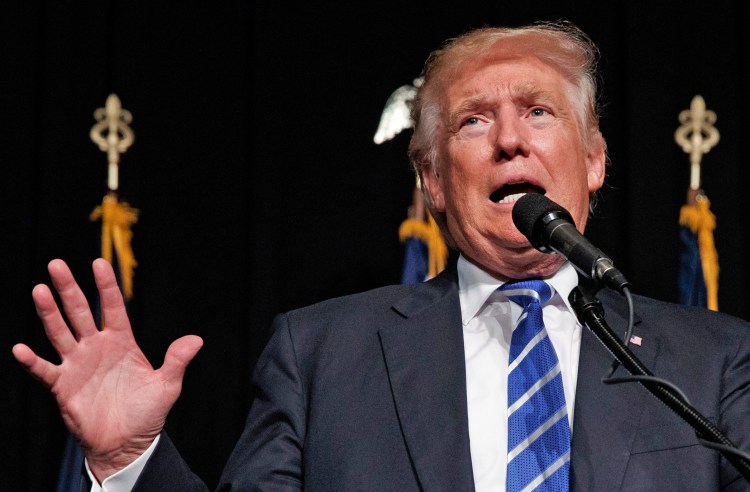WASHINGTON — His status as a presidential nominee barely a week old, Donald Trump is already tasked with assembling a complex transition team capable of hiring thousands of high-level government officials and crafting a detailed policy agenda should he win the presidency.
It’s a herculean task that will test the limits of Trump in particular, a political outsider who, thus far, has struggled to attract experienced talent to his presidential campaign. Experienced officials warn that the safety and economic security of the nation depends on both White House contenders aggressively preparing for the transition to a new presidency in the coming weeks, even as they intensify their political operations for the three-month sprint to Election Day.
The New York billionaire has shrugged off recent political stumbles that were created, in large part, by extraordinary understaffing and inexperience within his bare bones organization. Yet there is less room for error as the responsibility shifts from winning an election to governing the world’s most powerful nation.
“If you aren’t preparing, then the American public should be concerned about whether you’re fit to lead,” said Partnership for Public Service CEO Max Stier, who is helping both campaigns with transition planning through the non-profit’s Center for Presidential Transition. “The point of maximum vulnerability is when there is that handoff of power.”
Trump and his rival Hillary Clinton open formal transition offices on Monday in the same Pennsylvania Avenue building close to the White House, accommodations funded by taxpayers as part of $13 million Congress appropriated for pre-election planning.
Trump has entrusted much of the transition planning to New Jersey Gov. Chris Christie, his transition chairman, along with two longtime Christie loyalists, fundraising chief Bill Palatucci and former chief of staff Rich Baggar. Trump’s son-in-law Jared Kushner, a real estate developer, is also playing an active role along with Jamie Burke, who played a senior role in Mitt Romney’s transition team four years ago.
Trump’s team has identified experts in major policy areas such as foreign affairs, national security and economic affairs to help build out the transition, but those familiar with preparations to date describe them as preliminary at best.
A Trump spokeswoman did not respond to repeated questions about his transition planning. Brian Murray, a spokesman for Christie, said the governor is “just too focused on his job as chairman of the transition team to engage in press interviews right now.”
The experience of past candidates — and Trump’s struggles with his own campaign — suggests that the Republican nominee has a lot of work to do.
Romney’s 2012 team, dubbed the Romney Readiness Project, had 495 people working for the transition effort before Election Day and another 165 identified to join had he won the election, according to Stier’s office. Ahead of the 2008 election, the Obama-Biden Transition Project had more than 600 staff dedicated to the transition.
Trump’s transition has only a handful of staff so far and his entire campaign listed only about 70 people on the payroll and another few dozen consultants at the end of June, according to Federal Election Commission filings.
The goal is to create “a miniature federal government,” said former Utah Gov. Michael Leavitt, who led Romney’s transition team four years ago and is informally advising Trump.
There are just 73 days between the Nov. 8 election and the Jan. 20, 2017 inauguration when the new presidential takes over. Without a running start, Leavitt says that’s simply not enough time to appoint roughly 4,000 personnel that occupy senior roles in government departments — State, Defense, Homeland Security, Commerce, and Treasury among them — many requiring multiple security reviews or Senate confirmation.
“This is a responsibility of a candidacy,” Leavitt said. “You can’t transition power in the most important government in the world in 73 days.”
Like Stier, Leavitt noted that the nation is often most vulnerable during periods of transition. The 1993 siege in Waco, Texas, the Sept. 11, 2001 terrorist attacks and the 2008 economic meltdown all occurred within months of a new president taking over.
Beyond staffing key government agencies, the transition team is also charged with preparing to execute the new president’s policy prescriptions.
Four years ago, Leavitt’s team crafted a detailed plan for Romney’s first 200 days in office, which included prospective executive orders and legislation based on the candidate’s policy promises on the campaign trail.
The governing implications will likely help Trump attract top talent to his transition team, said Lanhee Chen, who served as Romney’s policy director four years ago and played an active role in transition planning at the time.
“There are many more people who would have greater comfort serving a Trump transition than a Trump campaign,” Chen said, citing the unusual opportunity for policy professionals to influence Trump’s governing agenda. “Some people believe they have an opportunity to shape something that’s been relatively formless.”
___
AP writer Chad Day contributed to this report.
Send questions/comments to the editors.


